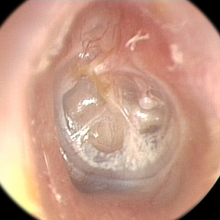Tympanic membrane retraction
Editor-In-Chief: Prab R Tumpati, MD
Obesity, Sleep & Internal medicine
Founder, WikiMD Wellnesspedia &
W8MD medical weight loss NYC and sleep center NYC
| Tympanic membrane retraction | |
|---|---|

| |
| Synonyms | Retraction pocket |
| Pronounce | N/A |
| Specialty | N/A |
| Symptoms | Hearing loss, ear fullness, ear pain |
| Complications | Cholesteatoma, hearing loss, ear infection |
| Onset | Can occur at any age |
| Duration | Chronic |
| Types | N/A |
| Causes | Eustachian tube dysfunction, negative middle ear pressure |
| Risks | Upper respiratory infection, allergies, sinusitis |
| Diagnosis | Otoscopy, tympanometry |
| Differential diagnosis | Otitis media, cholesteatoma |
| Prevention | N/A |
| Treatment | Observation, tympanostomy tube, surgery |
| Medication | Nasal steroids, antihistamines |
| Prognosis | N/A |
| Frequency | Common in children |
| Deaths | N/A |
Tympanic Membrane Retraction[edit | edit source]
The tympanic membrane retraction is a condition where the tympanic membrane, also known as the eardrum, is pulled inward towards the middle ear. This condition can lead to various complications, including hearing loss and cholesteatoma formation.
Causes[edit | edit source]
Tympanic membrane retraction is primarily caused by Eustachian tube dysfunction. The Eustachian tube helps equalize pressure between the middle ear and the external environment. When it fails to function properly, negative pressure can build up in the middle ear, causing the tympanic membrane to retract. Other contributing factors may include:
Symptoms[edit | edit source]
Individuals with tympanic membrane retraction may experience:
- Hearing loss
- Ear fullness
- Tinnitus
- Occasional ear pain
Diagnosis[edit | edit source]
Diagnosis of tympanic membrane retraction is typically made through otoscopy, where a healthcare provider examines the ear with an otoscope. The retracted eardrum may appear concave and may have reduced mobility when tested with pneumatic otoscopy.
Treatment[edit | edit source]
Treatment options depend on the severity of the retraction and associated symptoms. They may include:
- Observation for mild cases
- Treating underlying causes such as allergies or infections
- Myringotomy with or without tube insertion to ventilate the middle ear
- Surgical intervention in severe cases to repair the eardrum or address any complications like cholesteatoma
Complications[edit | edit source]
If left untreated, tympanic membrane retraction can lead to:
- Cholesteatoma
- Permanent hearing loss
- Middle ear infections
Prevention[edit | edit source]
Preventive measures focus on maintaining good Eustachian tube function and include:
- Managing allergies
- Avoiding upper respiratory infections
- Regular monitoring in individuals with a history of ear problems
See also[edit | edit source]
References[edit | edit source]
- Bluestone, C. D., & Klein, J. O. (2007). Otitis Media in Infants and Children. PMPH-USA.
- Schilder, A. G., et al. (2016). "Eustachian tube dysfunction: consensus statement on definition, types, clinical presentation and diagnosis." Clinical Otolaryngology.
Search WikiMD
Ad.Tired of being Overweight? Try W8MD's physician weight loss program.
Semaglutide (Ozempic / Wegovy and Tirzepatide (Mounjaro / Zepbound) available.
Advertise on WikiMD
|
WikiMD's Wellness Encyclopedia |
| Let Food Be Thy Medicine Medicine Thy Food - Hippocrates |
Translate this page: - East Asian
中文,
日本,
한국어,
South Asian
हिन्दी,
தமிழ்,
తెలుగు,
Urdu,
ಕನ್ನಡ,
Southeast Asian
Indonesian,
Vietnamese,
Thai,
မြန်မာဘာသာ,
বাংলা
European
español,
Deutsch,
français,
Greek,
português do Brasil,
polski,
română,
русский,
Nederlands,
norsk,
svenska,
suomi,
Italian
Middle Eastern & African
عربى,
Turkish,
Persian,
Hebrew,
Afrikaans,
isiZulu,
Kiswahili,
Other
Bulgarian,
Hungarian,
Czech,
Swedish,
മലയാളം,
मराठी,
ਪੰਜਾਬੀ,
ગુજરાતી,
Portuguese,
Ukrainian
Medical Disclaimer: WikiMD is not a substitute for professional medical advice. The information on WikiMD is provided as an information resource only, may be incorrect, outdated or misleading, and is not to be used or relied on for any diagnostic or treatment purposes. Please consult your health care provider before making any healthcare decisions or for guidance about a specific medical condition. WikiMD expressly disclaims responsibility, and shall have no liability, for any damages, loss, injury, or liability whatsoever suffered as a result of your reliance on the information contained in this site. By visiting this site you agree to the foregoing terms and conditions, which may from time to time be changed or supplemented by WikiMD. If you do not agree to the foregoing terms and conditions, you should not enter or use this site. See full disclaimer.
Credits:Most images are courtesy of Wikimedia commons, and templates, categories Wikipedia, licensed under CC BY SA or similar.
Contributors: Prab R. Tumpati, MD

